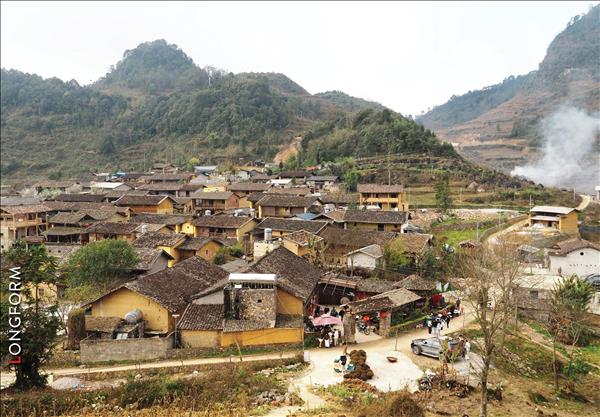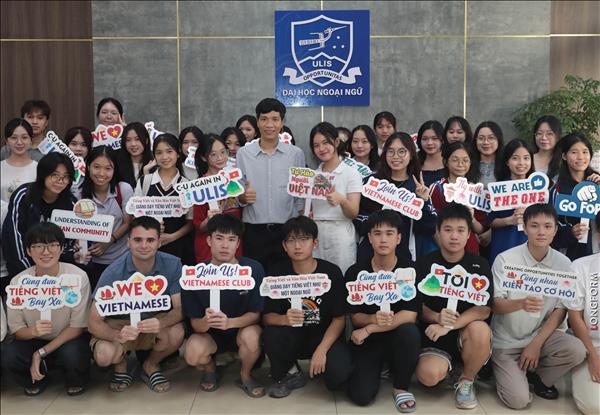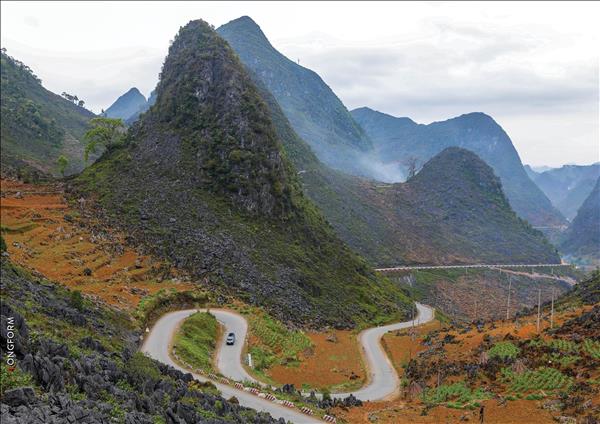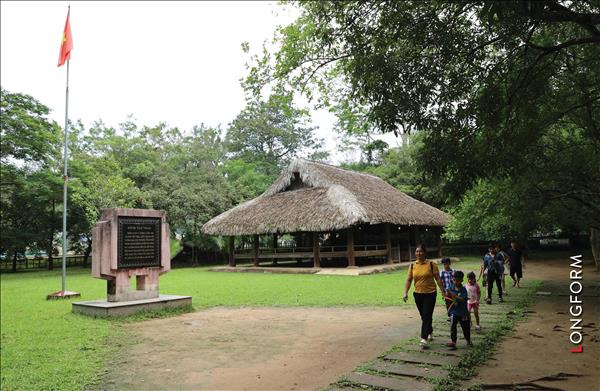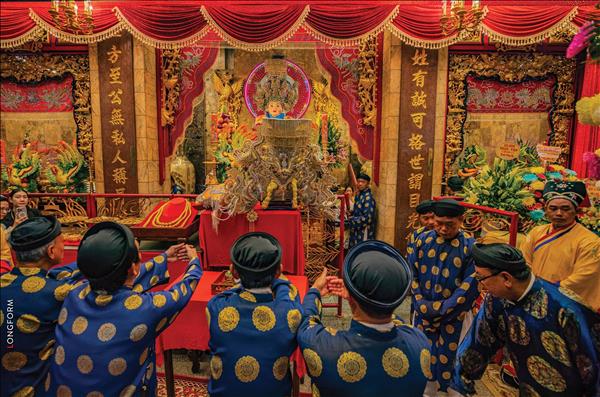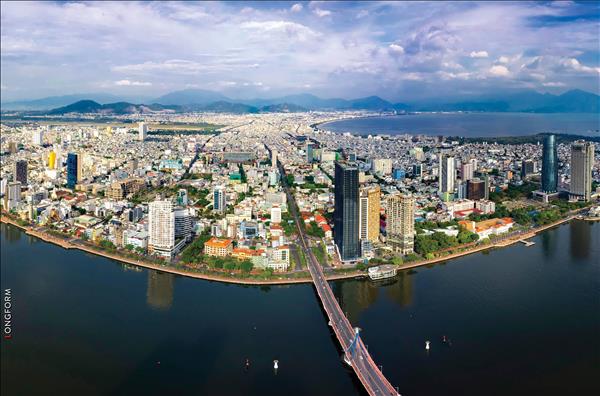The Editorial Board’s Foreword
In 1988, Vietnam Pictorial reporters, Le Phuc and Nguyen Vinh Quang, made their first trip to Truong Sa Archipelago (Spratly Islands). Since then, many reporters of the magazine have visited the Archipelago, and each trip left a new impression on them with new stories and new, lively images of the sacred islands and sea of the Fatherland. It was the same for young reporter Thao Vy. In 2013, when she started her career as a reporter, she made her first trip to Truong Sa where she had the feeling of visiting a peaceful and beloved area like other villages in Vietnam.
In 1988, Vietnam Pictorial reporters, Le Phuc and Nguyen Vinh Quang, made their first trip to Truong Sa Archipelago (Spratly Islands). Since then, many reporters of the magazine have visited the Archipelago, and each trip left a new impression on them with new stories and new, lively images of the sacred islands and sea of the Fatherland. It was the same for young reporter Thao Vy. In 2013, when she started her career as a reporter, she made her first trip to Truong Sa where she had the feeling of visiting a peaceful and beloved area like other villages in Vietnam.
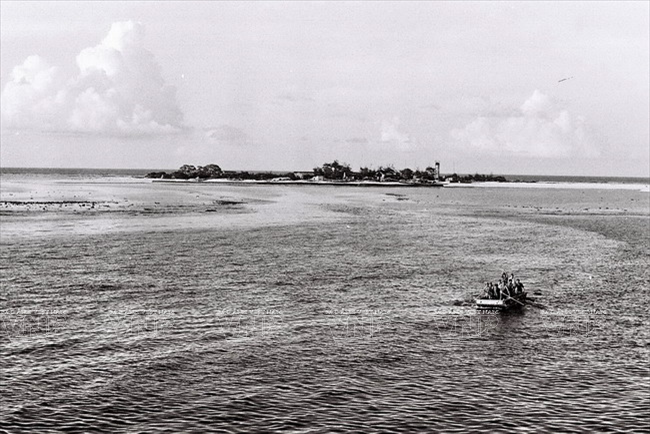 Sinh Ton Island is located in the centre of Truong Sa Archipelago in 1988. Photo: Vinh Quang/VNP 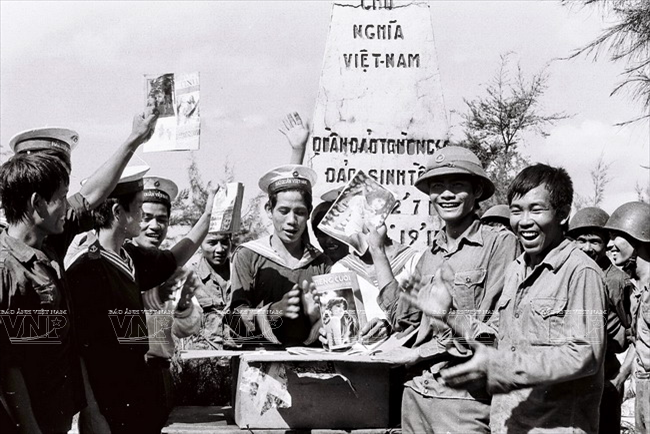 Soldiers at the sovereignty landmark on Sinh Ton Island of Truong Sa Archipelago in 1988. Photo: Vinh Quang/VNP 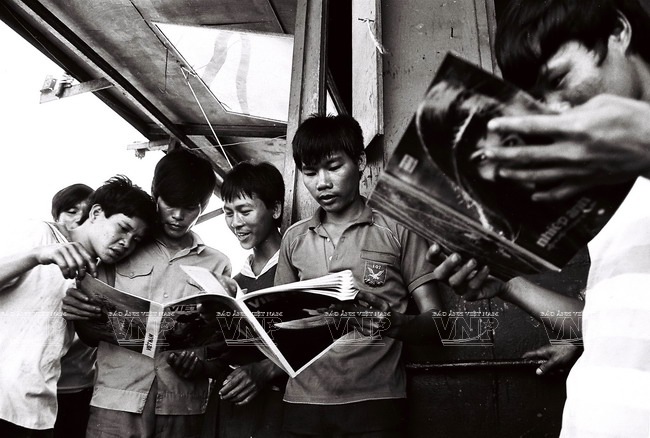 Soldiers on Co Lin Island of Truong Sa Archipelago in 1988. Photo: Vinh Quang/VNP  Photojournalists Le Phuc and Vinh Quang (left) in Truong Sa in 1988. Photo: File |
During our five days on Truong Sa Lon Island, the heart of Truong Sa Island District, if there had not been the sounds of the splashing waves we would have felt like we were on a mission on the mainland. Although the island is far from the mainland, the people’s love and the material facilities on the island are as abundant as in any other region of the country.
Perhaps, we were among the few people who were lucky to stay on Truong Sa Lon Island for such a long time, five days and four nights. It was thanks to this luck that we could see with our own eyes the life of the islanders here. On this island there is a “village” which is as peaceful as other villages of Vietnam, with the only exception that it lies on a vast ocean.
1. The first day: Our ship arrived at the port of the Truong Sa Lon Island at sunset. The sun nearly set into the water, mitigating the sultriness of the early summer days in June. The night with a gentle breeze dispelled our tiredness after two days on board of a ship at sea.
We set foot on the island on the day when there was a live TV programme broadcasting to the mainland. We were surprised at the sight of a stage with a modern audio system and lights. A system of high-voltage lights over the paths lit up the island. It was no exaggeration to say that Truong Sa Lon Island looked like a sparkling city on the sea.
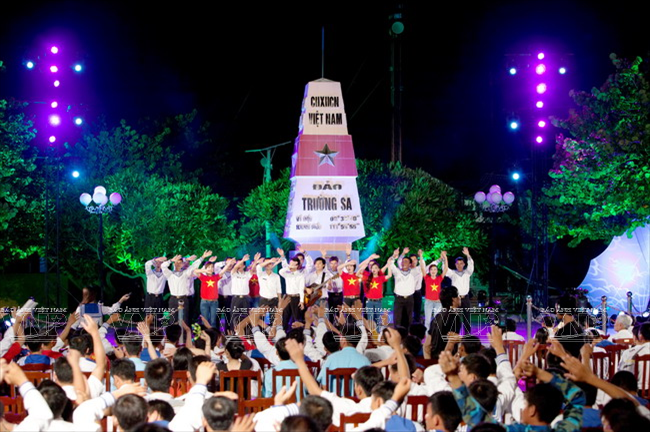 An exchange programme between people from the mainland and soldiers and islanders is held on Truong Sa Lon Island. Photo: Viet Cuong/VNP 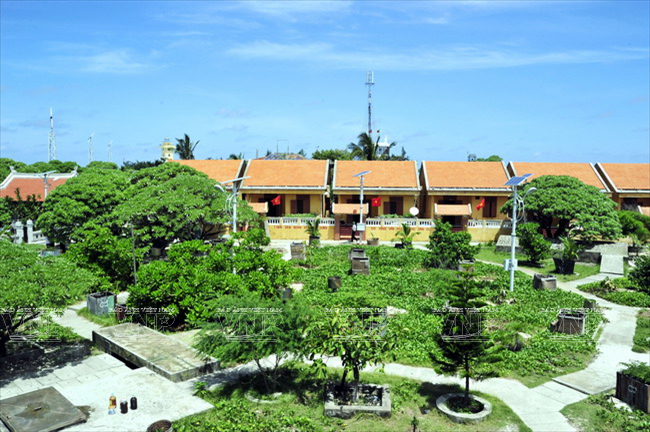 The residential area in Sinh Ton Island Commune. Photo: Tran Minh Ngoc 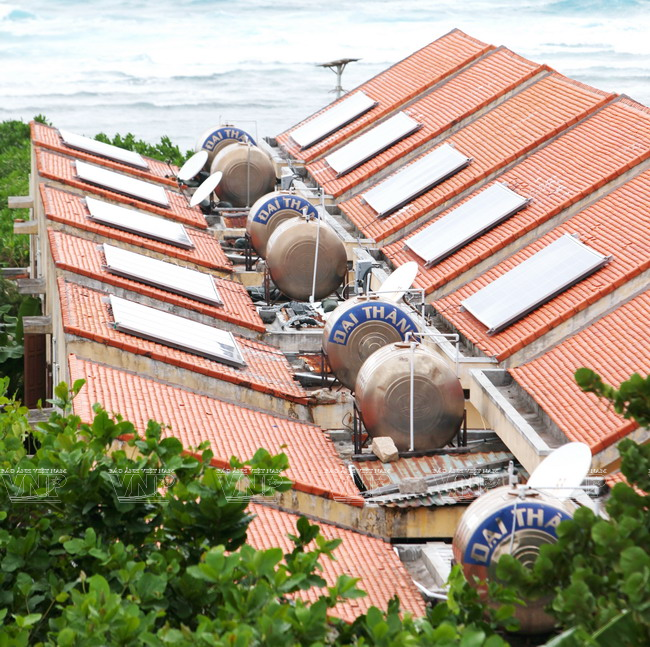 The solar panel system generates electricity on Truong Sa Lon Island. Photo: Viet Cuong/VNP  The wind power system on Song Tu Tay Island. Photo: Tran Minh Ngoc 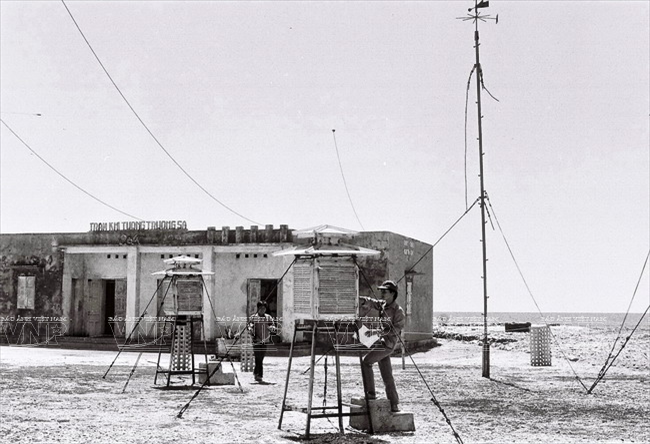 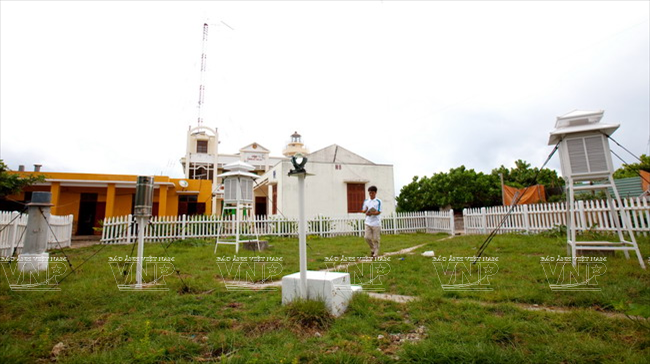 Truong Sa Lon Meteorological Station which provides updated weather forecasts to serve the islanders in Truong Sa Archipelago. The first photo was taken by photojournalist Vinh Quang in 1988 and the second by photojournalist Viet Cuong in 2013. |
While we were going along a path lit by the high-voltage lights leading to the residential area, Major Dinh Trong Tham, Deputy Military Chief in charge of logistics on the island said that the wind power system and solar energy have ensured electricity on the island nearly round the clock. In the season with stable winds, such as in the first six months of the year, the power is supplied to the households 24 hours a day.
Clean electricity on Truong Sa Lon Island has contributed to changing the lives of the islanders. We visited some households on the island and saw that all of them had television sets, refrigerators and computers. All conveniences in the houses are similar to that on the mainland. Seeing us, a little boy, Trinh Si and a little girl, Hong Huong, two citizens of the island, eagerly asked us to join them in watching a cartoon disc sent to them by their relatives from the mainland.
At night, we stayed at Thu Do Guest House on the island. The guest house has air conditioners, TV sets and water heaters. Lying on the soft cushioned bed, I could not believe I was on an offshore island.
2.The second day. At 5am, everyone got up to do exercises and prepare for a new day. At dawn, the island looked brilliantly yellow and the giant national flag made of ceramic, the largest flag of this kind in Vietnam, measuring up to 310m2 on the roof of the hall in the centre of the island looked more crimson. From the location of the flag, we saw the vast sea and a large space of the island with the wind turbines, a system of solar batteries, Truong Sa Lon Pagoda, residential areas and concrete roads leading to every lane.
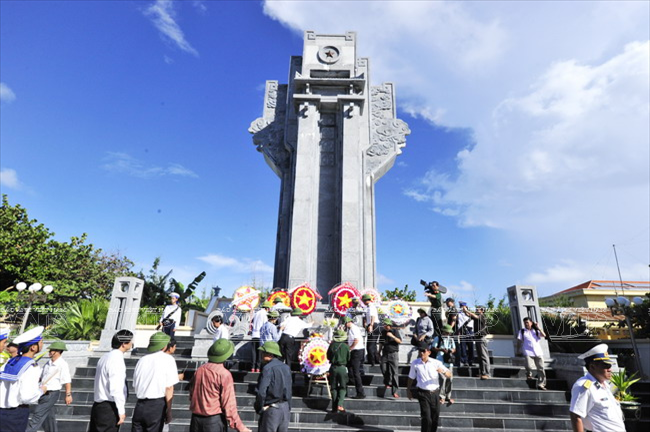 The Martyrs Monument on Truong Sa Lon Island. Photo: Tran Minh Ngoc 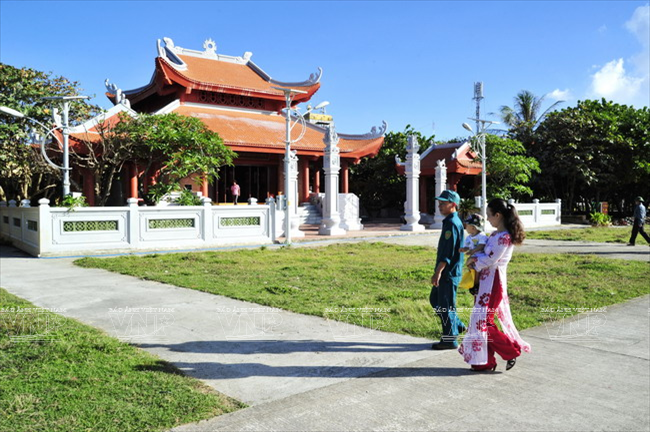 The President Ho Chi Minh Memorial House on Truong Sa Lon Island. Photo: Tran Minh Ngoc 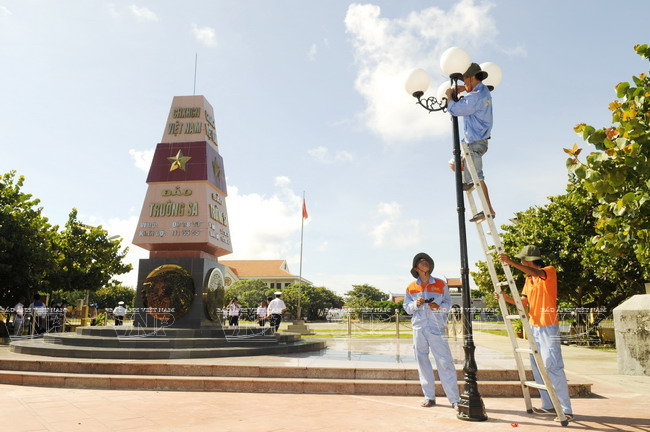 Maintaining the electrical system on Truong Sa Lon Island. Photo: Tran Thanh Giang/VNP 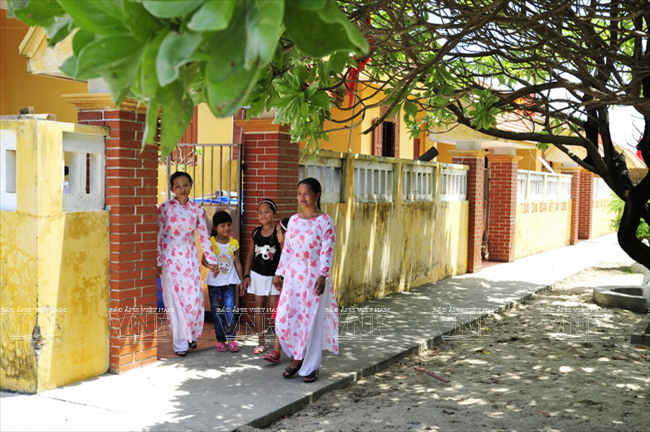 Islanders in Sinh Ton Island Commune. Photo: Tran Minh Ngoc |
I went along with a truck carrying goods to the households on the island. On the way I met many people going to the pagoda. The atmosphere was calm and warm. Truong Sa Lon Pagoda is large and wonderful, so some people consider it “a spiritual milestone at sea”. This shows that Vietnamese people have a strong faith, even living far from the mainland they still care about their spiritual life and religious beliefs.
3. The third day. At 5am, while I was still half asleep on the soft bed at the guest house, little Trinh Si pulled me up to go with him to attend the first summer class of the children on the island.
For the children on the island, the guests from the mainland like us are the most precious and desirable gift because they are eager to tell us their stories and hear the stories about the mainland. That’s the reason why only a short time after we reached the island they attached themselves to us.
I followed Trinh Si to his school, “Truong Sa Town Primary School”. It is a spacious two-story school lying under the canopies of Terminalia catappa and Heliotropium foertherianum trees. Although the school had no red banner and drum, the atmosphere was boisterous with the voices and laughter of the children.
Besides their curricular classes, Bui Thi Nhung, the only female teacher who was also the school principal, taught her pupils poems and songs about Uncle Ho, the island and sea and the Truong Sa Islands where they live and grow up.
In the afternoon, after school, they came back home and cycled along the lanes together. The atmosphere was cozy and peaceful.
| Truong Sa Archipelago consists of over 100 large and small islands, reefs and coral reefs and is surrounded by a vast sea area of approximately 160,000 - 180.000km2. Before the August Revolution, it was an administrative unit of Ba Ria Province. On December 21, 1933, Cochin China’s Governor Jean-Félix Krautheimer signed Decree 4762/CP putting Truong Sa Archipelago into Ba Ria Province. In the time of the Saigon administration Truong Sa belonged to Phuoc Tuy Province. After the country was reunified (1975), on December 9, 1982 Truong Sa District was officially established and belonged to Dong Nai Province. On December 28, 1982 under the Resolution of the 7th National Assembly, Truong Sa District was merged into Phu Khanh Province. On July 1, 1989, Phu Khanh Province was separated into Phu Yen and Khanh Hoa Provinces. Since then, Truong Sa District has belonged to Khanh Hoa Province. (Source: Khanh Hoa Portal) |
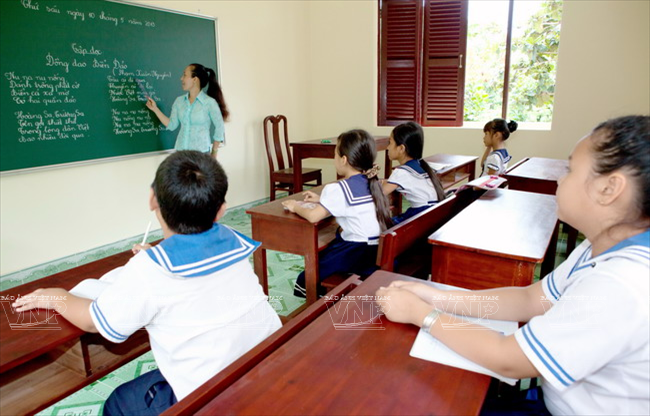 During a literature lesson on Friday, teacher Bui Thi Nhung teaches pupils a poem titled “Dong dao bien dao” (Children’s song about the sea) to promote the pride and love of the children for the nation’s sea and islands. Photo: Viet Cuong/VNP  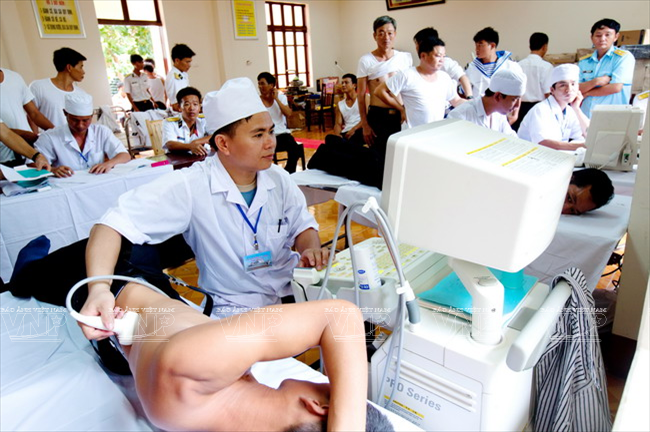 Every year, there are delegations from large hospitals on the mainland who come to Truong Sa Archipelago to give medical treatment to the islanders and soldiers. Photo: Viet Cuong/VNP 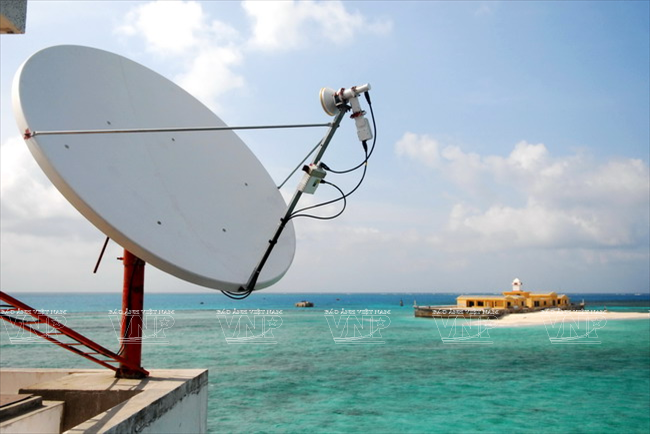 The telecom station on Da Tay Island, Truong Sa Archipelago. Photo: Tran Thanh Giang/VNP  Soldiers and islanders in Truong Sa can get access to the Internet. Photo: Tran Thanh Giang/VNP |
4. The fourth day. Not accustomed to the harsh weather here, I became sick. Following the instructions, I went to the island’s clinic to ask for medicine. Le Minh Phong, the clinic’s chief arranged a separate room for me in the clinic.
The clinic has all the necessary medical equipment. There is an X-ray machine, a blood test machine and a mobile decompression chamber for the treatment of the fishermen who are in distress while fishing at sea. The clinic has been provided with an online diagnostic system via satellite (Telecom medicin) by the 175 Military Hospital in Ho Chi Minh City. Thanks to this system and through the online guidance and direction of the doctors on the mainland, the doctors on Truong Sa Lon Island have successfully performed many complicated emergency operations.
5. The fifth day. Four days on the island have passed. As scheduled, at noon of the fifth day the ship will dock to take us back to the mainland. Knowing that we would soon be leaving the island, Thich Giac Nghia, a monk and verger of Truong Sa Lon Pagoda asked some people to prepare a small vegetarian meal at the pagoda to treat us. I and other members of our group also joined in making the food in a small kitchen owned by Thich Giac Nghia. The voices and laughter made me think of the reunion of a big family on a great occasion. The farewell party was warm and emotional. Everyone was happy and satisfied because they had seen their close relatives. Their eyes were wet with tears when they were going to say goodbye to their relatives who were going back to the mainland.
 A ceremony to commemorate the martyrs who laid down their lives for the nation’s sovereignty over the islands and sea. Photo: Tran Minh Ngoc  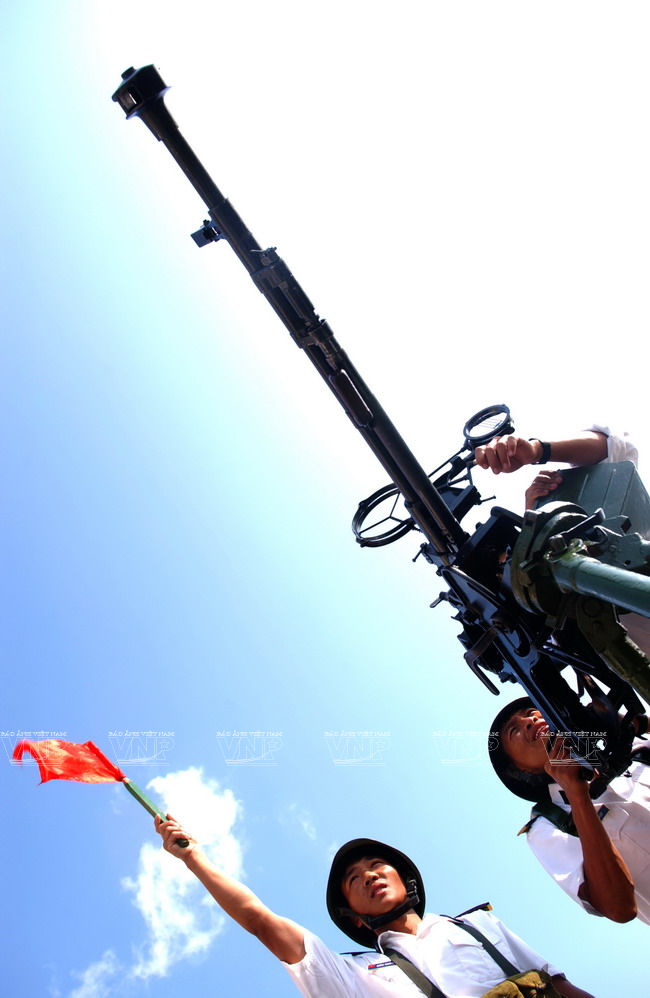 Soldiers on duty in Truong Sa Archipelago. Photo: Hoang Ha/VNP  Saying goodbye to soldiers in Truong Sa. Photo: Hoang Ha/VNP |
Saying goodbye to Truong Sa, the sacred land of the Fatherland, we had a strong belief in a bright future for the islands. Here, there are always energetic people who have a strong faith and are ready to stand side by side to build a peaceful and prosperous Truong Sa.
|
«
Truong Sa Island District always receives much attention and support from the Party, State and people in the country and overseas Vietnamese. The infrastructure and facilities on many islands in Truong Sa Archipelago, such as Song Tu Tay, Sinh Ton, Truong Sa Lon, were invested synchronously and firmly. The living standards of the islanders have been much improved. Therefore, Truong Sa will strongly develop and create firm bastions for the islanders.”Colonel Pham Van Hien, Chairman of Truong Sa Town’s People Committee |
Story: Thao Vy
Photos: Vinh Quang, Viet Cuong, Hoang Ha, Tran Thanh Giang & Tran Minh Ngoc
danghuyen


